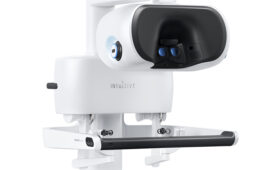
Omnivision’s OH02B10 image sensor [Photo courtesy of Omnivision]
NEWS RELEASE: New Medical Interface Connects Miniature Cameras for Single-Use Endoscopy
By Tehzeeb Gunja, Omnivision
Endoscopy has evolved over the decades as high-resolution imaging has become more advanced with image sensors now the size of a grain of sand. The range of applications in which endoscopy has proven useful include gastroenterology, airway management, gynecology, urology, arthroscopy, and cardiology. Intraoperative diagnosis, therapy, and minimally invasive surgery are all possible because of advancements in endoscopy.
Transitioning to Single-use Endoscopes
The medical industry is transitioning to single-use endoscopes to minimize cross-contamination and improve patient safety. The high cost of legacy technology based on charge-coupled device (CCD) image sensors and the overall system complexity make their use impractical in an exponentially growing single-use endoscopy market. Therefore, CCD-based image sensors cannot meet today’s high-performance endoscope requirements and are being phased out.
The drive to achieve greater imaging resolution with highest quality in a smaller footprint has motivated the industry to move to complementary metal oxide semiconductor (CMOS) devices and invest in continual improvement of the technology. CMOS image sensors offer lower cost, smaller size, and lower current consumption with better image quality and feature set.
CMOS Chip-on-Tip Technology
Extremely small image sensors using CMOS technology have been embedded on the tips of endoscopes, allowing cameras to enter the body through ever smaller natural orifices or incisions. State-of-the-art software and hardware for image processing enable high-speed video that serves as the “eyes” of the surgeon as he or she works inside the body, allowing surgeons to diagnose and treat therapeutically in real time.
A CMOS imager at the distal tip of the endoscope needs support an interface with high bandwidth, low pin count (small endoscope, outer diameter and cable size), uses a cost-effective cable and is immune to EMC/EMI and noise over a long transmission distance. All of these challenges are satisfied by a new medical interface: AntLinx.
The Move from MIPI to AntLinx
Mobile Industry Processor Interface (MIPI) is the current methodology used in endoscopy to transmit images from the camera at the distal tip to the back-end camera control unit (CCU). MIPI has wide bandwidth and transmits high-resolution images at high frame rates. However, to do so requires a minimum of 12 pins. This directly impacts the size of the imager used in the endoscope. Additionally, MIPI requires a thicker, more expensive cable that can transmit up to a maximum of only 1.5 meters reliably. These limitations result in endoscopes with larger outer diameters, thus causing patient discomfort.
To resolve the data transmission challenge over long cable lengths, current endoscopy systems convert MIPI output from the imager to other formats, such as low-voltage differential signaling (LVDS), fiber, or other serial interface. The converted signal is then transmitted to the handle or CCU, where it’s decoded to recover the imaging video data. This increases the system complexity, size, heat generation and cost of the endoscopy system in a single-use imaging solution.
Thus, camera and cable size, transmission length, signal integrity, and system complexity — as well as cost — need to be addressed to enable a solution that facilitates the implementation of cost-effective single-use endoscopes.
AntLinx has been recently utilized in the OCH2B – the smallest form factor 2.5×2.5mm CameraCubeChip package for disposable high definition (HD) resolution endoscope designs. The OCH2B CameraCubeChip is a complete camera module that features wafer level optics and a CMOS image sensor, the OH02B, which is the first square 2-megapixel (MP) (1500×1500) resolution imager. This solution is critical for the disposable endoscope market because it enables high resolution and small size, generates very low heat at the tip of the scope design, is cost-effective for one-time use, and helps endoscope designers to go to market faster with less design effort without the need to use interface converters. AntLinx further improves the CameraCubeChip module by enabling the thinnest 4-meter interface connection directly from the endoscope camera to the CCU tower or hand-held console. Collectively, AntLinx and OCH2B were designed with the patient in mind to maximize their care and comfort during endoscopic procedures.
Future Potential
Innovation in CMOS image sensors continues to help reduce their size, increase resolution, and improve image quality. Additional improvements in data transmission technology further enhance endoscopy applications. With these improvements, new endoscopy procedures are enabled that reach some of the smallest areas of the human body, helping to further reduce the need for open surgeries. As resolutions will increase in the future, AnLinx will scale accordingly in terms of higher bandwidth, lower latency and reduced power consumption.
About Tehzeeb Gunja
Tehzeeb Gunja joined Omnivision in August 2011 as Partnership and Business Development Manager for EMEA region and was appointed Director of Medical Marketing in March 2015. His current responsibilities involve leading the medical business at Omnivision including strategy formulation, product management, ecosystem, and business development.
The opinions expressed in this news release are the author’s only and do not necessarily reflect those of Medical Design & Outsourcing or its employees.

![A photo of the Medtronic GI Genius ColonPro polyp detection system flagging a potential sign of colon cancer during a colonoscopy. [Photo courtesy of Medtronic]](https://www.medicaldesignandoutsourcing.com/wp-content/uploads/2024/04/Medtronic-GI-Genius-doctors-268x170.jpg)


